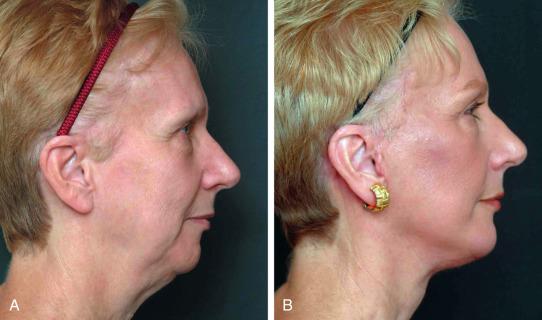Physical Address
304 North Cardinal St.
Dorchester Center, MA 02124
Chin augmentation has been performed using autografts, alloplastic materials, and mandibular advancement procedures. Autografts are complicated by the need for a donor site, difficulty with shaping the grafts, and their unpredictable pattern of resorption . In contrast, alloplastic implants have proved to be an easy and reliable means of augmentation. The most common method of augmentation is with alloplastic implants, including Silastic, Gore-Tex, Mersilene mesh, and Medpore implants . Silastic chin implants have the longest history of continuous use of any of the alloplastic implants. They have been safely used since the 1960s with a high degree of satisfaction. Mandibular advancement procedures require specialized equipment and add significant morbidity to the procedure with little advantage.
The most significant evolution in mentoplasty has been in implant design. The earliest Silastic implants were carved individually by the surgeon. In 1966 Safian and Dow Corning introduced the first preformed Silastic implants . These implants were equivalent to what is now referred to as a curvilinear implant or a central implant without a lateral component. Augmentation was isolated to the central mentum and provided only anterior projection. The next important advancement in implant design was the introduction of the anatomic style of implant by Toranto in 1982 . These types of implants have lateral tapering extensions, which wrap around the mandible, providing anterior projection of the mentum, filling of the prejowl sulcus, and an overall recontouring of the mandible. The result is a more natural augmentation of the chin–jawline complex. These implants are available as either anatomical chin implants (Spectrum Designs Medical, Carpinteria, CA, USA) or extended anatomical chin implants (Implantech, Ventura, CA, USA). Realizing the importance of isolated prejowl augmentation in certain patients, Mittleman introduced his prejowl implant, which has a thin central portion and provides bulk only in the lateral arms .
The surgical technique for mentoplasty using alloplastic implants has not significantly changed in recent years. The two common surgical approaches are an external technique through a submental incision and an intraoral technique through a gingivolabial sulcus incision. Both approaches are commonly used today, generally determined by the preference of the individual surgeon.
An optimal facial skeletal structure serves as the foundation for rhytidectomy and other facial rejuvenation procedures. Patients with poor skeletal foundations, as seen with microgenia, will not only tend to show certain stigmata of aging earlier, such as poor necklines and jowling, but will also obtain less than ideal results from a facelift. In the appropriate patients, correction of microgenia is a critical technique for facial rejuvenation, either as a stand-alone procedure or in conjunction with facelifting ( Fig. 22.1 ).

Alloplastic implantation provides a safe, reliable, and relatively simple means for chin augmentation. Ideally the implant should have a very low incidence of infection or rejection, provide predictable long-term results, and be easy to remove if necessary. Silastic, a nonporous material around which a fibrous capsule forms, meets all of these criteria .
Our preferred implants are the extended anatomic (Implantech), or anatomical (Spectrum Medical), implants; for the purpose of this chapter we will be referring to both as “anatomical chin implants.” These implants fill the central mentum and have lateral arms that fill the prejowl sulcus to produce a natural jawline. The lateral arms on these implants also account for the lower incidence of implant shifting relative to the central style implants. The anatomical style implants are available from each manufacturer in four sizes, providing between 5 and 9 mm of anterior projection. As the implant size increases, so does the length and bulk of the implant's lateral arms.
Central implants do not have a lateral extension to fill the prejowl sulcus. In patients with preexisting jowls, the central implant will accentuate the prejowl sulcus, often making the jowl appear more prominent. This is the opposite effect of the extended anatomical chin implant, which, by filling the prejowl sulcus, will reduce or camouflage the appearance of a jowl. In younger patients without jowls, central implants also have the negative effect of creating a more pointed appearing chin.
When performing mentoplasty we routinely have a 2-mm Silastic extension wafer available . The wafer provides a degree of intraoperative flexibility in terms of implant sizing. On intraoperative assessment, if the patient would benefit from further anterior projection, a wafer can be placed under the central portion of the chin implant, increasing anterior central mentum projection by 2 mm.
We perform all mentoplasties through a submental incision. The submental incision hides well and facilitates accurate implant placement, particularly for anatomical chin implants, which require a lateral subperiosteal pocket along the anterior-inferior mandibular border. The submental approach also allows for suture fixation of the implant to the mandibular periosteum, thereby preventing implant shifting and vertical migration. Implants placed through an intraoral approach are exposed to oral contaminants and have a greater likelihood for infection.
Become a Clinical Tree membership for Full access and enjoy Unlimited articles
If you are a member. Log in here